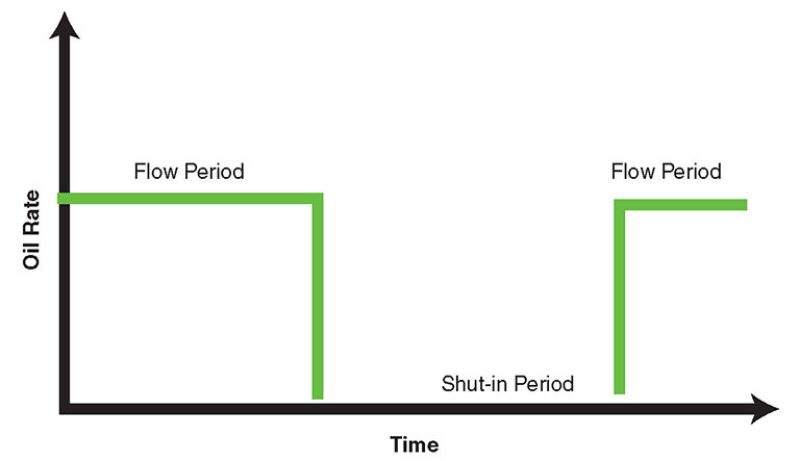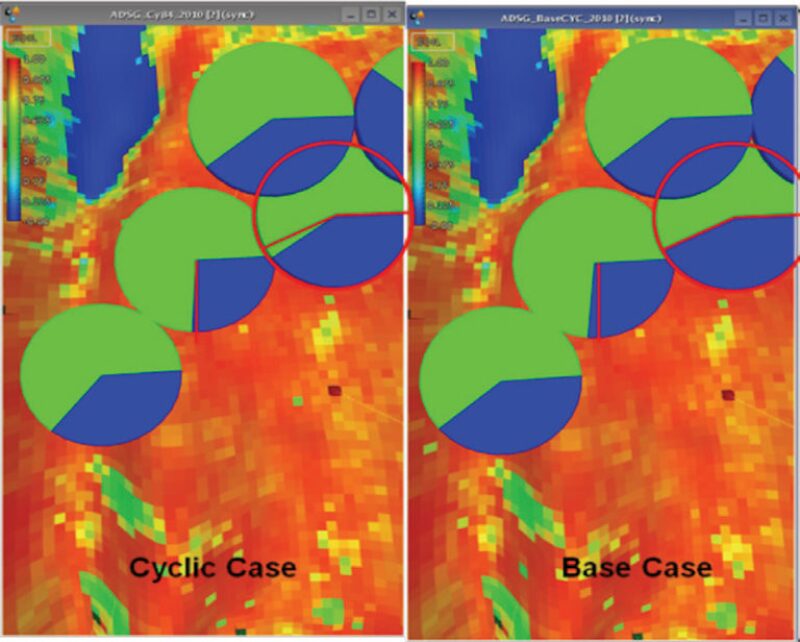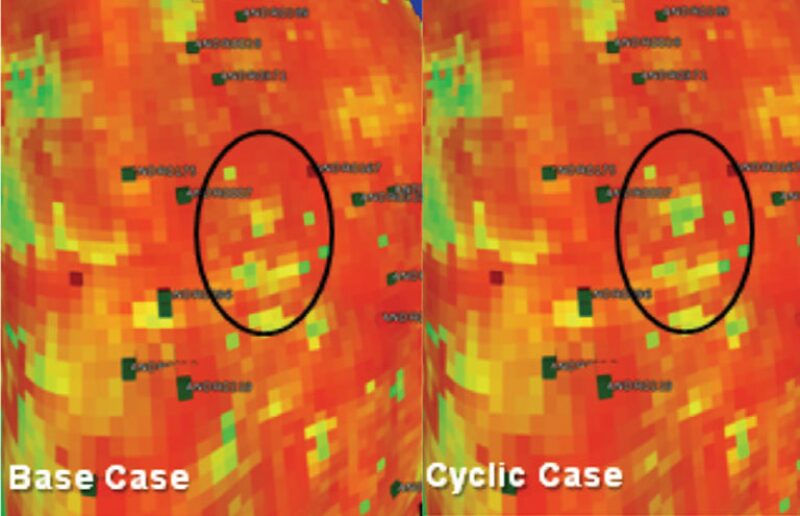Many strategies have been implemented to mitigate the problem of high water-production rates seen in mature fields. One of these is the cyclic-production scheme (CPS). This strategy, which requires alternately shutting and flowing wells with high water cut over a predetermined time, enhances sweep efficiency and pressure maintenance and reduces water-handling costs. In a reservoir-simulation model of a mature oil field evaluating a total of 93 wells, simulation runs involving several scenarios showed significant advantage in applying a CPS.
Introduction
Water management has become a key strategy in fields that have entered a high-water-cut development period. As fields mature, there is a natural tendency for water volumes to increase as aquifer and injected water advances toward the producers. Furthermore, increasing levels of water production can impair oil-production rates, in some cases to the point at which the well ceases to be economical to produce. Although injected water is an enabler for improved hydrocarbon recovery, it is essential to control water-production volumes and the flood front. High water production may limit oil production in a rate-limited well, increasing water-treatment and -disposal costs.
One option to reduce water production from high-water-cut wells is to convert to cyclic production. Cyclic wells are alternated between shut-in and producing phases that normally last for 6 months each. The result of closing in these wells is significant water reduction with minimal impact on oilfield production. The main benefit of the cyclic strategy is the reduction of water production, which allows optimization of the water-injection process, minimizing recirculation and allowing a better displacement of the waterflood front to the updip offset producers. Because less injected water is recirculated, the operational handling costs decrease and the economic efficiency of the water-injection project improves.
This study was implemented in a mature field as a part of water-management efforts to reduce water production. In this study, a reservoir-simulation model was developed on the basis of very fine geological characterization, and the field-performance history was matched. The model’s history matching was constantly updated by use of up-to-date -reservoir-surveillance, pressure, water-saturation (for flood-front detection), and new-infill-well data. The predictive capability of the reservoir-simulation model is very good. Simulation runs were conducted to analyze and optimize the impact of a CPS on the production performance of the field.
CPS Concepts
Fig. 1 illustrates the CPS with a certain period of shut-in time. In a cyclic-production mode, the mechanism of fluid movement is different from that in a normal-production mode. During the shut-in period, higher-density water segregates and separates from oil and settles down toward the lower portion of the oil column. Water coning and fingering will smear back to the lower part of the reservoir; hence, the well can produce oil at a reasonable rate during the production period.

One main advantage of cyclic production is less water coning (and lower water cut) during the production phase, because gravity segregation restores the oil column in the wellbore region during the shut-in phase. Another advantage is that cyclic production is particularly applicable to dead wells that have been revived but have marginal pressure potential. The shut-in period also allows the buildup of pressure potential.
The main objective of CPSs is to save reservoir energy by keeping water in the reservoir. In this way, reservoir pressure will be maintained to enhance sweep efficiency by disrupting the streamlines around the injection wells, directing the injected water to the uncontacted areas and recovering the bypassed oil. Also, there are other benefits of CPS related to gas/oil-separation-plant operations: minimizing surging conditions after reducing water production, controlling water-handling capacity for disposal wells, and optimizing demulsifier consumption.
Reservoir-Simulation-Model Description
The model used in this study is based on the latest geological models developed with detailed reservoir characterization. It offers fine layering (49 layers) and a grid size of 250 m, totaling 3 million cells. It includes detailed fracture modeling and petrophysical rock typing. The permeability distribution for this model is validated by transmissibility values obtained from pressure-transient analyses. The main history-match parameters include new enhanced permeability distribution, vertical transmissibility reduction, lower aquifer permeability, and localized fracture lineaments.
Selection Criteria and Implementation
The key parameter used in the selection of these candidates is well performance, because the water cut is above 60%, up to more than 90% with minimum oil contribution. The opportunities of reducing water cut in these wells successfully were found to be very limited because of the high advance of the waterflood front. Normally, oil columns of less than 20 ft are expected or have been identified in these wells. The designation of a producer as a cyclic well is made after other water-control methods such as water shutoff and workovers have been considered. Cyclic producers are selected in areas of thin oil columns and near peripheral water injectors.
This strategy was first implemented in 2005 with 22 wells mostly located in a thin oil column of less than 20 ft and spread throughout the entire field. Before this study, no evaluation through reservoir simulation had assessed the performance of these wells. The results of the CPS wells under these conditions are a significant water reduction with minimum impact on oilfield production.
History Matching
History matching is critical in simulation-model calibration because it allows the static geological model to be rationalized with production data. It is also critical in monitoring displacement processes, increasing understanding of reservoir flow dynamics, and predicting future production performance.
In this model, the historical production and pressures were calibrated and matched for the CPS wells used in this evaluation. The accuracy of the history matching was very high, reflecting the good quality of the reservoir-simulation model. With this good quality, the model can be used to simulate future reservoir performance with a high degree of confidence.
Evaluation Parameters
Duration of Shut-in Intervals. This part of the study aimed to determine acceptable timing for shut-in and open periods. The key parameter to assess through reservoir simulation is water reduction. Four different cycles were tested and evaluated.
After many simulation runs and evaluations, all well results showed that the best cyclic period is 8 months on, followed by 4 shut-in months, on the basis of reducing water and improving oil rate. Because of these results, this eight/four cycle has been used in the actual field-production optimization of cyclic wells.
Production Performance. The second parameter evaluated in this study was the production performance, assessed by following four major outcomes that contributed to a reasonable judgment of the CPS performance: oil production, water production, sweep efficiency, and offset-well performance.
Oil Production. An increase in oil rate is clearly shown when the wells were put on production. This increase in oil rate occurred because of the buildup of pressure and the oil accumulation in the top of the wellbore region during the shut-in peroid. Cyclic wells improve oil production in comparison with continuous production.
Water Production. The major objective in this study is to reduce water production. A reasonable correlation can be developed between the number of cyclic wells placed on production and the decrease in water-production amount. Here, water production has been decreased by approximately 20%. The CPS wells provide a high water reduction with minimal impact on oil field production. Fig. 2 shows cumulative oil and water for some cyclic wells. A greater reduction in produced water can be achieved using the CPS.

Sweep Efficiency. In the cyclic process, the incremental-production effect is reached because of the interplay of different production mechanisms such as capillary and viscous forces, gravity segregation, and compressibility effects, which lead to improved fluid crossflow and better reservoir sweep efficiency. In this study, sweep-efficiency improvement from flow-pattern redistribution has been observed and could make an additional contribution. This occurred because of the realignment of streamlines established in the field. Fig. 3 shows the improvement in the sweep in some parts of the field.

Offset-Well Performance. In this study, the effect of the CPS has also been evaluated for the offset wells around the cyclic wells. Cyclic wells have a significant impact on offset-well performance. It is clearly shown that the oil rate increased when a CPS was used. Improved performance of offset wells is observed in many areas and extends beyond the cyclic period, offering potential for the future.
Conclusion
There was a significant effect of the CPS in the optimization of oil production from the reservoir. Oil production was reduced slightly through an 8-months-on/4-months-shut-in cyclic time compared with continuous production of these wells. However, instantaneous increases in oil rate and a reduction in water production were observed in all reservoir-simulation cases. Because of gravity effects, cyclic production enhanced the oil rate and reduced total water production during the flow period. The study results showed that the CPS was a viable option for water-production management in oil fields. Cyclic production continues to be an effective practice in reducing water production and conserving reservoir energy in mature fields.
This article, written by JPT Technology Editor Chris Carpenter, contains highlights of paper SPE 164168, “Appraising the Performance of a Cyclic-Production Scheme Through Reservoir Simulation: A Case Study,” by Tariq Al-Zahrani, Saudi Aramco, prepared for the 2013 SPE Middle East Oil and Gas Show and Conference, Manama, Bahrain, 10–13 March. The paper has not been peer reviewed.
